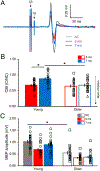Age-related strengthening of cerebello-cortical motor circuits
- PMID: 35810524
- PMCID: PMC11753508
- DOI: 10.1016/j.neurobiolaging.2022.04.016
Age-related strengthening of cerebello-cortical motor circuits
Abstract
Effective connectivity between the cerebellum and primary motor cortex (M1) is critical for motor learning and motor control. Despite evidence of cerebellar atrophy and declines in motor learning and motor control with advanced age, recent behavioral studies indicate that cerebellar-dependent motor learning processes are preserved or even enhanced in older adults. However, physiological evidence of heightened cerebellar excitability leading to strengthened cerebellar-M1 connectivity with advanced age is lacking. Here, we used transcranial magnetic stimulation to assess age-related effects on cerebellar inhibition, a measure of cerebellar-M1 connectivity, in 20 young and 19 older adults. We observed stronger cerebellar inhibition in older compared with young adults. The behavioral implications of strengthened cerebellar inhibition with advanced age found in this study remain to be determined.
Keywords: Aging, Cerebellum; Cerebellar inhibition; Primary motor cortex; Transcranial magnetic stimulation.
Copyright © 2022. Published by Elsevier Inc.
Conflict of interest statement
Disclosures
The authors have no actual or potential conflicts of interest.
Figures

References
Publication types
MeSH terms
Grants and funding
LinkOut - more resources
Full Text Sources

